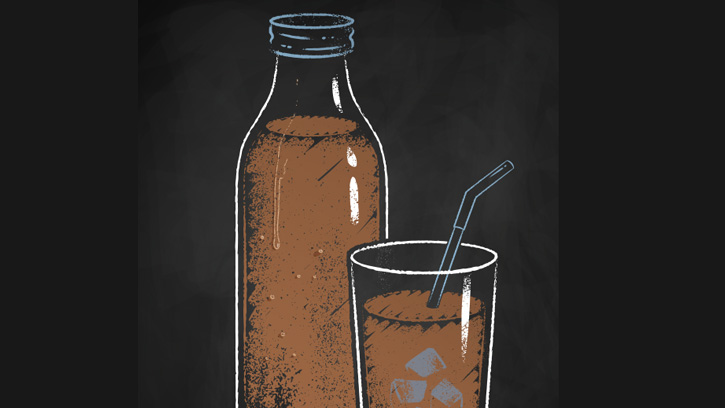Ready for a Better RTD Brew?
Science Forward | RESEARCH
READY-TO-DRINK (RTD) cold brew coffee drinks are increasingly popular with consumers, who are opting for higher-quality coffee, better flavor, less sugar, and fewer additives—attributes that contribute to cold brew’s positioning as a premium product. But for IFT member Gabriel Keith Harris and colleagues, taste testing a variety of commercial cold brews brought some unpleasant surprises that didn’t align with a value-added market position.
“We had been tasting a number of different cold brews, and we noticed how variable it was, and not always variable in a great way,” says Harris, associate professor and director of undergraduate programs for food science at North Carolina State University. The researchers wanted to see if they could improve the process of cold brewing coffee by finding a technique that would make a high-quality, tasty cold joe—and make it more quickly.
Improved Infusions
They made cold brew using four different methods: coffee infused directly in 4˚C cold water; a hot brew in 80˚C hot water; a hot water cold brew that mixed hot water with coffee grounds, which was then put into a cold water bath; and a brew that was microwaved to 80˚C, filtered, and then poured into bottles that were put in a cold water bath and refrigerated. Infusion times ranged from 2 min to 3 hr, and each method was prepared three times over the course of 12 days.
The NC State researchers found that the conventional process of mixing the coffee grounds with cold water extracted slowly and created a weaker and lighter-colored coffee with less caffeine as well as fewer other important components that contribute to coffee’s complex flavors, like chlorogenic acids.
The winner was the microwave method. While it’s well known that hot water extracts coffee more efficiently, what was particularly interesting, says Harris, was the speed with which it did so—to the point where it was difficult to measure how fast it was. Apart from saving time, this method also uses less coffee and water than standard cold brew preparation. “We were trying to show that we could use this brief heat treatment and it would produce a more intense cold brew with less coffee than you would typically use,” says Harris.
Safer Shelf Life
The second question the researchers wanted to answer was whether they could make a safer cold brew, which is important because there have been food safety issues with RTD cold brews. Death Wish Coffee, for example, issued a precautionary product recall after an external lab found the potential for botulin growth. The Death Wish cold brew was made by canning the coffee and pumping in nitrogen, which replaces the oxygen, explains Harris. If the pH is 4.6 or higher, that can lead to food safety problems, “especially if it’s canned in a low-oxygen environment,” he says.
Making a shelf-stable product that doesn’t require refrigeration is difficult without a “kill step” like heating. Using the traditional canning approach will cook the product, however, says Harris, and that isn’t great for the flavor.
Even some of the refrigerated RTD coffees didn’t taste good, says Harris, who detected mold in the flavor and aroma. “Something went wrong,” he says. “If you had even a mild heat treatment, that mold wouldn’t have made it.”
Some of the shelf-stable samples the researchers drank looked like coffee but didn’t taste like coffee. The formulators made the product safe to the detriment of the flavor, which is particularly concerning because consumers are leaning toward lighter roasts, and those are the roasts where quality defects are very evident, Harris explains. “They’ve made it such that it doesn’t need to be refrigerated, but whatever process that they subjected this to was so intense that it ruined the coffee flavor,” he says.
Harris and his colleagues envision a better process. His team members are now at work on research that compares their lab samples with commercial cold brew products.


